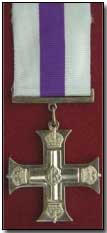Encyclopedia - Military Cross
 The British Military Cross
was instituted on 28 December 1914 as a means of formally recognising the
courage of junior officers during wartime (officially for "gallantry in the
field" for Captains and below).
The British Military Cross
was instituted on 28 December 1914 as a means of formally recognising the
courage of junior officers during wartime (officially for "gallantry in the
field" for Captains and below).
In this way the Military Cross complemented the Military Medal which was awarded to servicemen below officer rank.
Also available was an additional award of a Bar to the Military Cross to recognise further acts of gallantry. Such silver bars were worn above the ribbon.
Until the institution of the Distinguished Flying Cross (DFC) in June 1918 many officers of comparable rank within the air service were similarly awarded the Military Cross in recognition of their daring aerial exploits.
From 1931 the MC (as it was known) was also awarded to Majors. Although recipients were not initially permitted to list the letters MC after their name this restriction was subsequently withdrawn.
Awards of the MC were announced in the London Gazette along with a citation, other than for those awarded as part of New Year or Birthday honours. Some 37,081 MCs were awarded during the First World War, plus 2,992 first Bars, 176 second Bars and 4 third Bars.
A Town Major was a staff officer responsible for billeting arrangements in a town or village behind the lines.
- Did you know?
